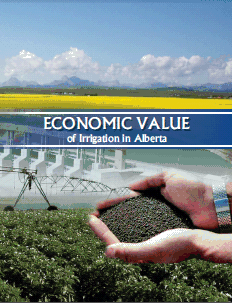| |
Background
Irrigation in Alberta, which began in the late 1800s, now takes place on about 690,000 hectares. This represents almost 70% of Canada’s total irrigated area. The majority of Alberta’s irrigation (566,000 hectares) occurs within the 13 irrigation districts, which are in the South Saskatchewan River Basin. An additional 125,000 hectares are irrigated throughout the province as private developments.
Alberta’s irrigation industry has played a significant role in enhancing the province’s economic and social well-being. Irrigation allows the production of a diverse array of crops in the province that cannot be grown under dryland conditions, which allows producers to take advantage of a wider range of national and international markets. As well, intensive livestock feeding operations in the irrigated areas provide a ready market for calves and feed grains. In times of low precipitation or drought, feed and forages from irrigation farms help supplement dryland producers impacted by feed shortages.
Much has changed in Alberta's agriculture and irrigation industry since the last comprehensive economic analyses were carried out. The Economic Value of Irrigation in Alberta study was implemented to provide an up-to-date assessment of the value of Alberta's irrigation industry and its future role in Alberta's economic landscape. |
 |
Study Objectives
The study assessed the economic impact of the irrigation industry on a regional basis as well as on a provincial basis. The following were the key components of the study.
- Evaluation of the economic, environmental, and social impacts that Alberta's irrigation industry has on the Southern Irrigation Region and the province.
- Specific economic objectives assessed the value of irrigation and related infrastructure for:
- Primary agricultural production;
- Backward linkages;
- Forward linkages; and
- Government revenues.
- Other agricultural and non-agricultural benefits of irrigation were also assessed.
- Overall cumulative economic impacts of irrigation in Alberta were developed.
- Opportunities to strengthen the future value of Alberta's irrigation industry, and challenges related to climate change and the growing demand for water in the province.
The economic assessment was carried out on all lands that were actually irrigated from 2000 to 2011 within the 13 irrigation districts, as well as private irrigation projects throughout Alberta.
Key Study Findings
The results of this study show that Alberta's irrigation industry continues to play a significant role in growing the province's economy and increasing the social well-being of Albertans. In the future, irrigation will become an even more important economic driver as the world's demand for high quality processed food products continues to increase.
- Alberta's irrigation industry annually contributed about $3.6 billion to the provincial gross domestic product (GDP).
- The irrigation agri-food sector contributed about 20% of the total provincial agri-food sector GDP on 4.7% of the province's cultivated land base. Almost 90% of the GDP generated by irrigation accrued to the region and the province, and only 10% to irrigation producers.
- Gross domestic product multipliers indicate that for every $1.00 of irrigation sales, the total GDP increased by $2.54 and labour income increased by $1.64. Total employment increased by about 39 jobs for every $1.0 million of irrigation sales.
- Every cubic metre of water delivered for irrigation and other related uses generated about $3.00 to the provincial GDP and $2.00 in labour income. Every $1.00 invested by the Government of Alberta (GOA) in irrigation-related activities generated $3.00 in added revenue to Alberta and Canada.
- Sales of irrigation crop and livestock products on 4.7% of Alberta's cultivated land base generated 19% of total primary agricultural sales. Irrigation sales equated to about $2,400/ha compared with about $329/ha for dryland production – about seven times greater.
- Irrigation generated about $1.3 billion in annual revenue for the GOA and the Government of Canada. Government revenues always exceeded expenditures, with the revenue to expenditure ratio of about 3:1.
- Benefits from irrigation water and infrastructure used for non-irrigation purposes, such as recreation, hydropower generation, drought mitigation, and commercial fishing, generated an additional $85 million to the provincial GDP and $71 million in labour income.
- While an economic value was not determined for the 32,000 hectares of habitat development in the irrigation districts, its value in enhancing wildlife populations and biodiversity is considered priceless.
- The future will provide opportunities and challenges for Alberta's irrigation industry. Increased frequency, duration, and intensity of droughts may occur as a result of climate change. Long-term water and drought management strategies will allow irrigation districts to better optimize water supply and irrigation production during prolonged droughts.
- Climate change may also lead to more diverse and high-value irrigated crop production, and encourage establishment of additional processing industries in the region. The message – that water; land; skilled irrigation producers; and diversified, high-quality irrigation products are available to support value-added processing industries – needs to be better communicated to international food processing industries.
- The communities and industries supported by Alberta's 13 irrigation districts are an excellent template for what a strong, vibrant rural economy can achieve – because of water. Irrigation districts can continue to play an important role in the expansion of rural development opportunities within the districts and in surrounding dryland regions in southern Alberta.
Acknowledgements
Prepared as information for the Alberta Irrigation Projects Association; funding for this project was provided through Growing Forward 2, a federal-provincial-territorial initiative. The views and opinions expressed in this report are not necessarily those of Agri-Food Canada or Alberta Agriculture and Forestry |
|